Effect of Different Growing Media on the Growth and Germination of Mango
Binyamin khan*1, Saleha Tawab1, Nawab Ali3, Shamsher Ali2, Muhammad Mehran Anjum3 and Waseem Zaman1
1Department of Horticulture, the University of Agriculture, Pakistan
2Department of Soil and Environmental Science, the University of Agriculture, Pakistan
3Department of Agronomy, the University of Agriculture, Pakistan
Submission: July 19, 2017; Published: August 28, 2017*Corresponding author: Binyamin khan, Department of Horticulture, the University of Agriculture Peshawar, Pakistan, Amir Muhammad Khan Campus Mardan, Pakistan, email: binyaminkhan05@gmail.com
How to cite this article: Binyamin k, Saleha T, Nawab Ali, Shamsher Ali, Muhammad M A, Effect of Different Growing Media on the Growth and Germination of Mango. Int J Environ Sci Nat Res. 2017;4(3): 555636. DOI: 10.19080/IJESNR.2017.04.555636
Abstract
A trial to study the “Effect of different rowing media on the growth and germination of mango” was conducted at Horticulture Nursery; The University of Agriculture Peshawar Amir Muhammad Khan Campus Mardan during the year 2015. The experiment was laid out in Randomized Complete Block Design with single factors, factorial arrangement having three replications. The mango seeds were planted in sand + Baggas + pine bark (1:1:1), sand + baggas + pine bark (1:2:1), sand + baggas + pine bark (1:1:2), sand + baggas + pine bark (2:1:1). Data was recorded for germination percentage, plant height, number of leaves plant"1, leaf area. Almost all parameters were significantly affected by growing media. Maximum germination percentage (100%), leaf area (69.4cm2) was recorded for seed sown in growing media composed of sand + baggas + pine bark (1:1:1), while maximum number of leaves (7) plant-1, plant height (33.71 cm) was recorded for seed sown growing media composed of sand + baggas + pine bark (1:2:1). Minimum germination percentage (55.55%), plant height (18.54cm), leaf area (27.04cm2) and number of leaves (3.67) plant-1was recorded for media composed of Sand + baggas+ pine bark (1:1:2).
Keywords: Growth media; Germination and mango
Introduction
Mango belongs to the genus Mangifera of the family Anacardiaceae. The genus Mangifera contains several species that bear edible fruit. Most of the fruit trees that are commonly known as mango belong to the species Mangifera indica. The other edible Mangifera species generally have lower quality fruit and are commonly referred to as wild mango. Mango has become naturalized and adapted throughout the tropics and subtropics. Much of the spread and naturalization has occurred in conjunction with the spread of human populations, and as such, the mango plays an important part in the diet and cuisine of many diverse cultures. There are over 1000 named mango varieties throughout the world, which is a testament to their value to humankind. Mango is a common garden tree throughout the tropics. Based on production, mango ranked second after citrus in Pakistan and fourth in the world production Malik [1] Pakistan produces 8.5% of world’s mango. In Pakistan area under mango cultivation is 167.5 thousand hectares with the production of 1,732 thousand tones. Pakistan earns Rs. 4.9 billion from mango exports in 2014. Pakistan has exported 86 thousand tons of mangoes to the different countries of the world in 2014 [2]. Annual estimated world over production of mango is over 25 Million tones.
More than half of mango area (104.9 thousand hectares) lies in Punjab followed by Sindh (50.0 thousand hectare) with minor acreage in Baluchistan (1.4 thousand hectare) and Khyber Pakhtunkhwa (0.3 thousand hectares). But due to favorable conditions, fruits are mature early in Sindh and get its supply catches the Punjab market in early stages and fetches high prices. Besides this also suppresses the prices of local early maturing varieties in Punjab due to suitable conditions in the market [2].
Worldwide, among 1595 varieties of mango known, only few (25-30) are being grown on commercial scale. Important commercial cultivars of Pakistan are Dashehari, Anwar, Ratul, Langra, Chaunsa, Sindhri, Maldha and Fajri. These varieties are consumed at their peaks in summer seasons. These varieties are commonly available one after the other in summer seasons. However each variety takes over the consumption after it reaches the market. The consumption of Sindri is the highest among all other indigenous varieties (Report on mango from Pakistan) The mango fruit is used and processed in various ways, e.g. mango juice, mango slices, powdered, candied pulp, Jams, paste, jelly, squashes, chutney, preserves, cider, ketch up and pickles. The ripe fruits are used in cooking. The juice particularly of the fibrous cultivars is squeezed out and dried on plates [3].
Although grown widely, mangos prefer a warm, frost-free climate with a well-defined winter dry season. Rain and high humidity during flowering and fruit development reduces fruit yields. The tree generally flowers in mid- to late winter, with fruit maturing in the early to mid-summer months. Mango trees are usually between 3 and 10 m (10-33 ft) tall but can reach up to 30 m (100 ft) in some forest situations. The canopy is evergreen with a generally spreading habit. The heavy canopy of the mango is a source of shelter and shade for both animals and humans. Mangos are well adapted to cultivation and have been grown commercially for centuries.
Today, mangos are recognized and eaten throughout the world and are regarded as one of the most popular and esteemed tropical fruits. Mangoes require deep soils with good drainage not necessarily fertile but mangoes can thrive in a wide range of soil types. Mango is mostly propagated by vegetative method. Approach grafting is mostly used for commercial plantation. The seedling tree has some major drawbacks. Propagation from seed, though easy and cheap, is unable to perpetuate characters of the parent tree because most commercial varieties in Pakistan are cross pollinated and mono embryonic. Such plants are not uniform in growth, yield and fruit quality and it has long juvenile phase in comparison to vegetatively propagated fruit crops. In case of asexual method, propagation is brought by the plant parts. The asexually or vegetatively propagated fruit plants are true to type and are uniform in growth and fruit quality. Growing media is the important input for the containerized seedling production. It is characterized by light weight, friable, good water holding capacity, drainage, porosity and low bulk density etc. Normally the viability of stone is about 90-100 days. However, it depends on the storage conditions. Stones sown immediately after extraction will exhibit viability up to 60-80 per cent depending on the variety [4] Looking to above fact, the present experiment was undertaken to find out effect of different growing media on growth of mango.
Materials and Methods
The experiment "Effect of different growing media on the growth and germination of mango" was conducted at Horticulture Nursery, The University of Agriculture Peshawar Amir Muhammad Khan Campus Mardan during the year 2015. The main objective was to determine the best growing media for the better growth rate and germination percentage of mango.
Media Preparation and Bulb Plantation
The media used in this experiment was prepared by thoroughly mixing sand, baggas and pine bark at different ratios. Mango seed were sown in black polythene bag of size 8x12 inches with required media, tree seed per treatment were sown and replicated three times. Thus total 36 seeds were sown for four different types of growing media.
Experimental Design
The experiment was carried out in Randomized Complete Block Design (RCBD) with single factor, Factor arrangement replication three times. There were 4 treatments in each replication. Experiment was based upon following factor. i-e growing media.
Factor A (Growing media)
M1: Sand + Baggas + Pine bark (1:1:1)
M2: Sand + Baggas + Pine bark (1:2:1)
M3: Sand + Baggas + Pine bark (1:1:2)
M4. Sand + Baggas + Pine bark (2:1:1)
The mango seeds were sowed in flat manner in each bag, and the following parameters were studied.
Parameters
The following parameters were checked regularly during the passage of study:
Germination percentage
The germination percentage was calculated with the help of germination formula given below:
Germination percentage = (number of germinated seeds / total seeds) x 100
Plant Height (cm)
The plants to be measured were selected randomly .Plant height was taken from the top of soil to the peak of plant with measuring tape.
Number of leaves plant-1
The plants were randomly selected and the leaves were counted.
Leaf area (cm2)
Leaf area (cm2) was measured with the help of measuring tape by the following formula.
Leaf area (cm2) = L x W
Results and Discussion
Germination Percentage
The data recorded for germination percent is given in (Table 1) and analysis of variance is presented in (Table 1a). The analysis of variance showed that data related to germination percentage were non-significantly different. The mean table showed that maximum germination (100%) was recorded for seeds sown in Sand + Baggas + Pine bark (1:1:1), followed by (88.89%) in Sand + Baggas + Pine bark (2:1:1), while minimum germination percentage (55.55%) was noted in seeds sown in Sand+ Baggas +Pine bark (1:1:2).Pine bark increases acidity of the media [5] and high acidity decreases germination capacity [6] As Sand + Baggas + Pine bark (1:1:2) has high proportion of pine bark than sand and baggas that's why it had minimum germination percentage (Table 1).
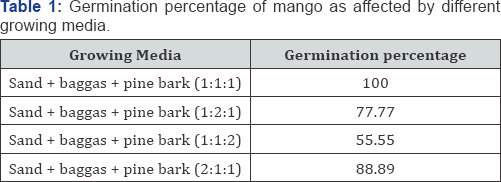
LSD value = 36.817

The value of probability is 0.1059 which is non-significant.
Plant height (cm):
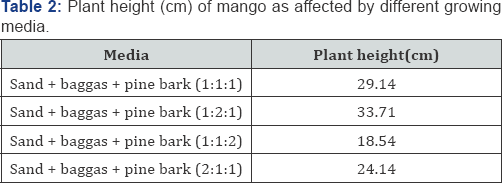
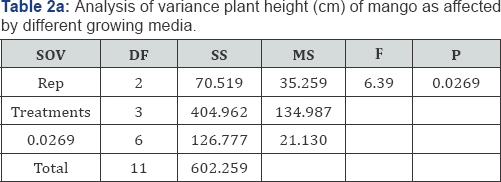
CV 17.34
The value of probability is 0.0269 which is significant. LSD value = 10.906
The data recorded for germination percent is given in (Table 2) and analysis of variance is presented in (Table 2a). The analysis of variance showed that data related to plant height were significantly different. The mean table showed that maximum plant height (33.71cm) was recorded for seeds sown in Sand + Baggas + Pine bark (1:2:1), followed by (29.14cm) in Sand + Baggas + Pine bark (1:1:1), while minimum plant height (18.54cm) was noted in seeds sown in Sand+ Baggas +Pine bark (1:1:2).Minimum plant height in media composed of Sand + Baggas + Pine bark (1:1:2) might be due to the minimum germination of seeds in this media. As minimum germination due to higher acidity of media contribute poor development of plant seedlings [7] and weak seedlings ultimately produce less plant height (Table 2).
Leaf area (cm2):
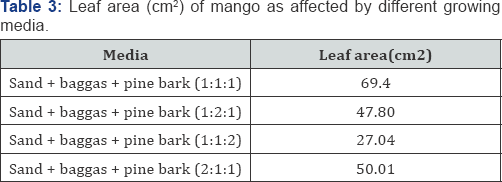
LSD value = 27.499.
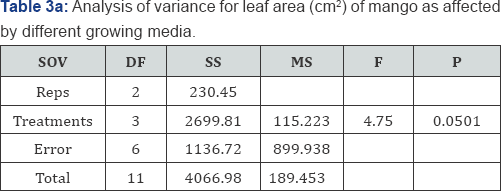
CV 28.34.
The value of probability is 0.0501 which is significant.
The data recorded for leaf area is given in Table 3 and analysis of variance is presented in (Table 3a). The analysis of variance showed that data related to leaf area were significantly different. The mean table showed that maximum leaf area (69.4 cm2) was recorded for seeds sown in Sand + Baggas + Pine bark (1:1:1), followed by (50.01cm2) in Sand + Baggas + Pine bark (2:1:1), while minimum leaf area (27.04cm2) was noted in seeds sown in Sand+ Baggas +Pine bark (1:1:2).Minimum leaf area (27.04cm2) in Sand + Baggas + Pine bark (1:1:2) might be due to the fact that this media composition decreased the pH of media and low pH (high acidity) has negative impact on plant growth and germination [8] which resulted in producing small leaves with minimum leaf area (Table 3), [9,10].
Number of leaves plant-1
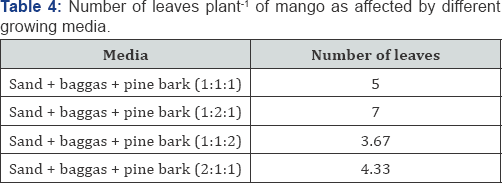

CV 22.85
The value of probability is 0.0498 which is significant.
The data recorded for number of leaves is given in Table 4 and analysis of variance is presented in (Table 4a) The analysis of variance showed that data related to leaf area were significantly different. The mean table showed that maximum number of leaves (7) [11-14] was recorded for seeds sown in Sand + Baggas + Pine bark (1:2:1), followed by (5) in Sand + Baggas + Pine bark (2:1:1), while minimum number of leaves (3.67) was noted in seeds sown in Sand+ Baggas +Pine bark (1:1:2).Minimum number of leaves (3.67) in Sand + Baggas + Pine bark (1:1:2) [15-18] might be due to the fact that this media composition had higher proportion of pine bark than sand and baggas which led to increase in acidity of the medium . High acidity of the medium had a negative effect on green parts of the seedlings [6] and thus produced minimum number of leaves per plant. (Table 4), [19-20].
Conclusion and Recommedation
On the basis of collected data the following conclusion was obtained,
Among all the different growing media Sand + Baggas + Pine bark (1:1:1) was the most effective for maximum germination percentage and leaf area while Sand + Baggas + Pine bark (1:2:1) was recorded as best for maximum plant height and number of leaves plant-1.
Based on the above conclusion, following recommendations are made; For better germination growing media composed of Sand + Baggas + Pine bark (1:1:1) is recommended under the Agro-climatic condition of Mardan.
References
- Asgharipour (2011) effects of planting depth on germination and the emergence of fieldbindweed (convolvulusarvensis l) Asian j agric sci 3(6): 459-461.
- Ahmed hm (2006) Organic seedling production of tomato and pepper in relation to vermicompost.asian. J Plant Sci 3(2): 243-245.
- Awan aaa, Iqbal m J, U rehman, g Idris (2003) Response of olive hardwood cuttingsto different growth media and basal injuries for propagation. asian J Plant sci 2(12): 883-886.
- Barney dL, wM Colt (1991) Using bark and sawdust for multches, soil amendments and potting mixes. Corporative extention system, agricultural experiment station, college of agriculture, university of Idaho info series no. 858.
- Deska J, k Jankowski, a Bombik, j Jankowska (2011) Effect of growing medium ph on germination and initial development of some grassland plantsacta sci. Pol agricultura 10(4): 45-56.
- Dolor d (2013) effect of fruit fermentation on the germination and growth of irvingiawomboluseedlings Amer. J Biotech Mol Sci 1(2): 4550.
- Dolor d (2011) effect of propagation media on the germination and seedling performance of irvingiawombolu(vermoesen). amer j biotech mol sci 1(2): 51-56.
- Dolor de, Fo ikie, Gu nnaji (2009) effect of propagating media on the rooting of leafy stem cuttings of irvingiawombula( vermoesen).res j agric and bio sci 5(6): 1146-1152.
- Farouk as, Hs salih (2003) influence of plant spacing and seed size on yield components of caser bean under irrigation sudan agric j 12: 4-13.
- Ganolly SRR singh, SL katyal, D singh (1980) mango in indica. In: the uango indian council of agricultural research new delhi. 467.
- Malik MN (1994) fruit crops. Published book horticulture st printers, Rawalpindi, Pakistan, pp. 437-487.
- Mango festival (2014) Brief on pakistani mangoes in sindh. pp. 1-2.
- Mayer AM, A Poljakoff-mayber (1989) The germination of seeds. Pergamon press oxford 14. Mbakwe, ssc onyekwelu and vc umeh 2004 seed germination of depulped and undepulped fruits of bush mango irvingiawombula (venicosen). Nig j hort sci 7(1): 1150-1155.
- Neelam A, ishtiaq, (2001) Response of eucalyptuscamaldulensis seedlings to different soil media Sarhad. J Agric 17(1): 75-79.
- Orwa ca mutua, r kindt, r jamnadass , a simons ( 2009) agro forestry trees database: A tree reference and selection guide version 4.0.
- Parasana js, Hn leua, Nr ray (2013) effect of different growing medias mixture on germination and seedlings growth of mango ( mangiferaindica l.) Cultivars under net house conditions.asian. J bio sci 8(3): 897-900.
- Parasana js, Bn satodiya, ka patel, Nr ray, Gp panchal (2012) effect of mixture of growing media on germination and seedlings growth of mango ( mangiferaindica l.) cultivars under nethouse conditions. asian. j bio sci 7(2): 409-411.
- Perez-fernandez MA, E Calvo-magro, J Montanero-fernandez, jA Oyola- velasco (2006) Seed germination in response to chemicals: effect of nitrogen and ph in the media. J Env Biol 27(1): 13-20.
- Radha t, l Mathew (2007) Fruit crops: hort Sci Ser, India. 3: 237.
- Rahman h, M rafiq, N ghulam, a samad (2007) effect of soil media on peach seed germination and seedling growth in climatic conditions of orakzai agency (fata). Sarhad j agric 23(3): 689-691.






























